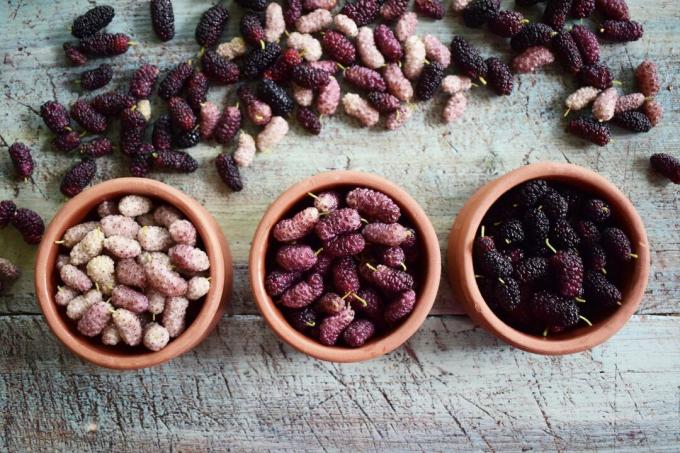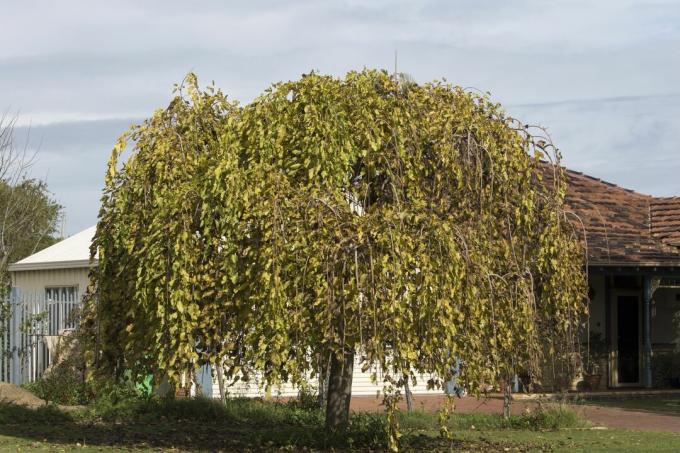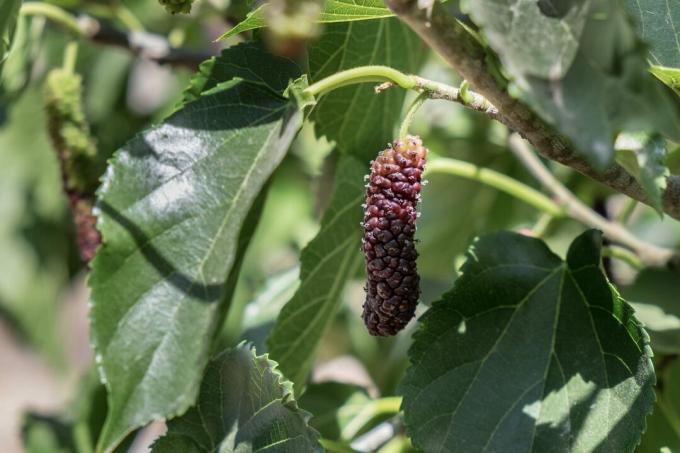Depending on the species, mulberries grow as a shrub or tree with white, red or black fruits. We present different types and varieties of mulberry.

The genus of Mulberry trees (More) is diverse and there are various types and varieties for planting in the home garden or in pots. In this article we give you an overview of different varieties of the mulberry.
"Contents"
-
White mulberry
- Varieties of white mulberry
- Ornamental forms of the white mulberry
- Black mulberry
- Red mulberry
- Asian mulberry
- Large fruited mulberry
- Japanese mulberry
- Dwarf mulberry trees
White mulberry
The white mulberry tree (More alba) comes from East Asia and has been cultivated in China for over 4,500 years. It prefers sunny, light, calcareous and sandy soils. The foliage of the medium-sized tree was mainly used for food by silkworms, but it also produces many sweet, white to red-black fruits. It was also planted as an ornamental tree.
The white mulberry can be planted individually, in groups or in wild protective hedges. However, it is also very suitable for strictly trimmed hedges and as a topiary. Here you will find an overview of the numerous fruiting varieties and ornamental forms of the white mulberry.
Varieties of white mulberry
- ‘Aurefolia’: Mulberry variety with light green leaves and golden yellow autumn colors. It forms pale purple, white and sweet-tasting fruits with a honey-like scent.
- ‘Constantinopolitana’: Mulberry with a strong but compact growth. The 5 cm long, sweet fruits first turn yellowish when ripe, then later black-red.
- ‘Emanuelle’: French variety with striking light purple, about 3 cm long fruits. The small tree reaches a height of about 5 m.
- "White Sofia": Small tree about 5 m tall. The variety makes 4 cm long white fruits with a purple coating and a very sweet taste.

Ornamental forms of the white mulberry
- ‘Nana’: Globular, shrubby growing mulberry with dense growth up to 3.5 m in height and width. Does not produce any fruit, as the plants are mostly purely male.
- ‘Pendula’: mulberry tree with pendulous growth, also called black mulberry. The tree can reach heights of 2 - 6 m and forms dense arbors under the overhanging branches. It forms small, red-black fruits when ripe.
- Sycamore-leaved Mulberry Tree (More alba f. macrophylla): Small tree with a stature height of 3 - 10 m and leaves shaped like a plane tree.
- ‘Pyramidalis’: Columnar mulberry tree with a height of 10 - 16 m. The few fruits are 1 - 2 cm small and white in color.
- ‘Spirali’: zigzag mulberry or corkscrew mulberry with twisted shoots. The growth is shrubby up to 4 m in height and width. The large leaves can be 20 cm long.

Black mulberry
The black mulberry (More nigra) comes from western Asia and has meanwhile also immigrated to America and southern Europe. The small tree, which needs warmth, thrives in protected areas with a wine-growing climate. The preferred lime-rich and nutrient-rich soil should be warm and sunny. The black-violet fruits taste much more aromatic than those of the white mulberry.
- ‘Agate’: large shrub or small tree 3 - 5 m high. The 3 - 4 cm long fruits ripen in late summer and taste sweet and aromatic.
- ‘Black Persian’: Central Asian variety with very large black fruits up to 6 cm long and 3 cm wide.
- ‘Kaester’: High-yielding mulberry variety from Los Angeles with very sweet, about 4 cm long black-red fruits.

Red mulberry
The red mulberry (More rubra) is at home in the east of the USA and can grow up to 15 m high in its homeland. It prefers moist locations, which is why it is often found on river banks. Its fruits hardly differ from those of the black mulberry. However, they are slightly smaller at 3 cm in length and turn red or red-black when ripe. The foliage of this species turns bright golden yellow in autumn. There are only a few selections of this type, crosses with More alba however, are far better known.
- ‘Gelso Rosso’: Slow growing Italian variety of red mulberry with a final height of only 3.5 m.
- Morealba x rubra ‘Illinois Overbearing’: Cross of white and red mulberry. Abundant, black fruit variety with good winter hardiness in mild areas and later ripening time.
- Morusalba x rubra ‘Wellington’: A variety of white and red mulberry bred in New York by Richard Wellington. Fertile variety with aromatic, black fruits and a long harvest time.

Asian mulberry
The Asian Mulberry (Morus australis), also called Korean or Chinese mulberry, comes from East Asia. It used to be called More alba var. stylosa counted among the white mulberries. It feels good on limestone soils and grows even in colder locations, it forms a 2 to 3 m height tall shrub with deeply lobed small leaves and numerous black and red approximately 1 cm in size Fruits.

Large fruited mulberry
The large-fruited or long mulberry (Morus macroura) lives up to its name with fruits up to 10 cm in length. They are therefore significantly longer than the fruits of all other species. The large-fruited mulberry needs warmth and should be planted in mild climates. It is hardy to a maximum of -10 ° C. The ideal location is in full sun on deep, nutrient-rich and moist soils.
- ‘Pakistan Red’: Mulberry with a height of 5 m and comparatively good winter hardiness. The 7 - 8 cm long fruits turn deep red to black-red when ripe and taste aromatic and sweet.
- "Giant Pakistan": This variety makes the largest mulberry fruits with a length of up to 10 cm. These taste sweet and aromatic, stay rather firm and are therefore easy to store. "Giant Pakistan" is hardy to -10 ° C and can reach a height of 10 m.

Japanese mulberry
The Japanese Mulberry (More kagayamae; synonym More bombycis) grows as a large shrub or small tree. The older leaves are notched like a plane tree. It reaches a height of 5 to 8 m and forms small, blackberry-like, red-black fruits. The sweet and fruity taste is also reminiscent of blackberries, which is why this type is also offered as blackberry plane tree. There are very few varieties of this species, such as ‘Shin-Tso’. The optimal location for the Japanese mulberry is sunny, warm and protected on nutrient-rich, well-drained soil.

Dwarf mulberry trees
- Morus acidosa ‘Mulle’: Mulberry with weak growth from Swedish breeding. The small trees are extremely hardy and do not grow taller than 3.5 m even when they are old, and with pruning measures are significantly smaller. Many small, blackberry-like fruits with a sweet and sour taste already hang on young trees. In addition to a warm, full sun location, ‘Mulle’ prefers well drained, nutrient-rich and fresh soils.
- Morus rotundiloba ‘Mojo Berry’: dwarf mulberry up to 1.5 m and good winter hardiness down to -15 ° C. This extremely slow growing mulberry variety is also suitable for pot cultivation. In sunny locations with a good supply of nutrients and well-drained soil, this dwarf mulberry is particularly fruitful. The numerous sweet fruits ripen one after the other between June and September.

After selecting the right species and variety, it is time to plant the Mulberry trees. Find out everything about location requirements, care measures and harvesting the exotic fruits in our article.



